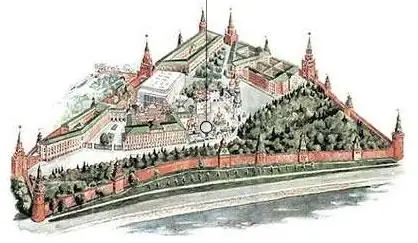- Author Harold Hamphrey [email protected].
- Public 2023-12-17 10:06.
- Last modified 2025-01-24 11:10.
Smolny Cathedral (St. Petersburg) was erected at the direction of the great Empress Elizabeth. The daughter of Peter I was going to be tonsured and serve God in the very place where she grew up, where she spent her youth.

Designed by B. Rastrelli (one of the best architects of the time). The majestic building soared up 94 meters and could accommodate 6,000 people. Nearby it was planned to build the highest bell tower in Russia (140 meters, which exceeded the height of the spire of the Peter and Paul Cathedral). But these plans were not destined to come true. Rastrelli died, and the architect's followers decided that the conciseness of the city's landscape would be violated from such a high bell tower.
The monastery complex was built for almost 90 years, the last works were completed only in 1835
The first name of the monastery is Resurrection Novodevichy (the cathedral was consecrated in 1748). Later, the monastery began to be called none other than Smolny (for brevity). In 1765, the Smolny Cathedral received the first pupils of noble birth, after which Catherine decided to open another school for girls of a lower class (Alexander Institute). The building, designed by the architect Y. Felten, carriedfeatures of early classicism.

The next part of the ensemble is the Smolny Institute. This solemn classical building was designed in 1864 by another architect, J. Quarnegi. It was here that the Petrograd Soviet was located in 1917.
Unfortunately, after the revolution, the Smolny Cathedral was looted, and the premises began to serve as a warehouse. The iconostasis of the temple was dismantled only in 1972, and the opening of the concert and exhibition complex, which is still here, took place at the end of the last century (1990).
Smolny Cathedral (St. Petersburg), bearing a combination of white stone molding and heavenly blue walls, is surrounded by four corner churches. Nearby - residential complexes, decorated with two-tiered arcades. House churches have only one helmet-shaped dome with a cross. They seem to be built into the wall.

According to the original plan of Rastrelli, the Smolny Cathedral was supposed to look like a mighty one-domed temple (in the manner of European temples), but Empress Elizabeth rejected this proposal and wished to see her spectacle with five domes. In fact, the temple itself has only one dome (central), and the remaining four are nothing more than bell towers, having a concave shape and consisting of two tiers. The bulbous dome is installed at the top, and the belfry occupies the second tier.
The openwork fences of the temple, cast according to Stasov's drawings, still retain the status of the most highly artistic in St. Petersburg.
The leadership of the work on the interior decoration was entrusted to the architect V. Stasov. The interior turned out to be both simple and solemn at the same time. The huge church hall with three iconostases was finished in marble, a crystal balustrade was installed in front of the altars, and the pulpit was decorated with the finest carvings. Of the many relics, the icons "Introduction of the Virgin" and "Resurrection of the Cross" (A. Venetsianov) have survived.
Smolny Cathedral is one of the monuments of world significance. Today the complex has the status of a branch of the State Museum "St. Isaac's Cathedral". This is a venue for concerts, exhibitions of painting and graphics. It is open to tourists and true connoisseurs of culture.






